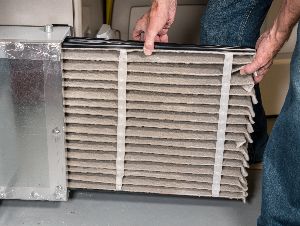A Guide to HVAC Air Filters in the Home

Traditional heating and air conditioning units provide a steady supply of warm or cool air to keep indoor areas comfortable. To do this cleanly and efficiently, they use a filter that removes debris from intake air, purifying it before circulating it through the ductwork and vents in your home. Here's what to know about your system's air filter and when to replace it.
Why Do HVAC Filters Need Changing?
Filters trap particulate matter, such as dirt, dust, pollen, and pet dander, as it enters your HVAC system. Over time, the filter becomes saturated with debris. If it's not replaced, pollutants may recirculate through your indoor air. This can produce musty odors and cause you to inhale allergens and impurities, leading to allergy flareups and asthma attacks.
Additionally, your heating and air conditioning unit will have to work harder to pull intake air through the clogged filter, causing it to use excess energy that will drive up your monthly utility bills. This can also put stress on mechanical components like the blower motor and fans, resulting in breakdowns. Changing the filter can improve the quality of your indoor air, keep energy expenses to a minimum, and prevent the need for HVAC repairs.
When Does It Need Changing?

HVAC contractors recommend replacing the filter at least once per season, with a monthly swap being ideal. However, if you or a family member experiences allergenic rhinitis or asthma, you might want to swap it out every other week to improve air quality and facilitate easy breathing. The same advice applies if you have indoor pets or like to smoke inside the home.
The season can also dictate this schedule. For instance, when the pollen count rises during spring or mold grows more rampantly during hot and humid summers, you might change the filter a couple of times per month to account for higher volumes of airborne allergens.
Where Can You Find the Filter?
The location of the filter depends on the type of heating and air conditioning unit. If the system has a return duct attached on the side of the handler, you'll likely find the filter in a slot near the duct. If it's a vertical unit with a return duct on top, you'll notice a filter that slides out above the handler. If the system is vertical with a duct that emerges from the bottom, you may find the filter in a slot below the handler.
Meanwhile, units with return grilles located on walls or ceilings within the home have filters just inside them. Consult your owner's manual to learn more about where your filter is located and how to replace it. You can also reach out to an HVAC professional for help and advice regarding the best fit for your home.
Keep your heating and air conditioning units running dependably with help from Vickers Heating & Air Conditioning. This HVAC contractor provides routine maintenance along with repairs and new installations to clients throughout Conyers, GA, with an emphasis on customer service and year-round comfort. Call (770) 483-9272 to book an appointment for annual upkeep, and visit the website to find out how they'll make your home energy-efficient throughout every season.
About the Business
Have a question? Ask the experts!
Send your question

